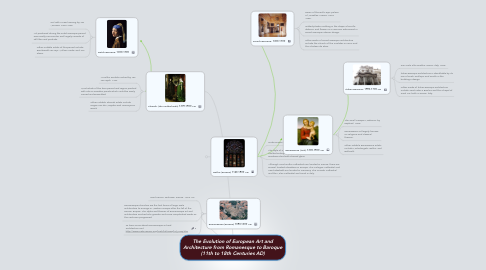The Evolution of European Art and Architecture from Romanesque to Baroque (11th to 18th Centuries AD)
von Ta'Nice Perkins

1. Dutch Baroque, 1600-1700
1.1. Girl with a Pearl Earring by Jan Vermeer. Circa 1665
1.2. Art produced during the Dutch Baroque period was mostly non-secular and largely consists of still-lifes and portraits.
1.3. Other notable artists of this period include Rembrandt van Rijn, William Heda, and Jan Steen.
2. Flemish (The Netherlands) 1375-1500 AD
2.1. Arnolfini Double Portrait by Jan van Eyck, 1434.
2.2. Most artists of this time period and region painted with oils on wooden panels which could be easily carried and assembled
2.3. Other notable Flemish artists include Rogier van der Weyden and Hieronymus Bosch
3. Romanesque (Europe) 1050-1200 AD
3.1. Saint Sernin, Toulouse, France. 1070 AD.
3.2. Romanesque churches are the first forms of large scale architecture to emerge in Western Europe after the fall of the Roman Empire. The styles and themes of Romanesque art and architecture evolved into grander and more complicated works as the centuries progressed.
3.3. To learn more about Romanesque art and architecture visit http://www.metmuseum.org/toah/hd/rmsq/hd_rmsq.htm
4. Gothic (Europe) 1140-1500 AD
4.1. Notre Dame de Chartres, France. 1142 AD.
4.2. The style of of Gothic Architecture includes high vaulted ceilings, flying buttresses and large windows inlaid with stained glass.
4.3. Although most Gothic cathedrals are located in France, there are several located elsewhere in Europe. The Cologne Cathedral and Saint Elizabeth are located in Germany. The Orvieto Cathedral and the Milan Cathedral are found in Italy.
5. French Baroque, 1600-1700
5.1. Room of the Bull's Eye, palace of Versailles, France. Circa 1680.
5.2. Gilded plaster molding in the shape of scrolls, ribbons, and flowers is a common adornment in French Baroque interior design.
5.3. Other works of French Baroque architecture include the Church of the Invalides in Paris, and the Chateau de Blois.
6. Italian Baroque, 1550-1700 AD
6.1. San Carlo alle Quattro. Rome, Italy. 1665.
6.2. Italian Baroque architecture is identifiable by its use of ovals, scallops, and scrolls in the building's design.
6.3. Other works of Italian Baroque architecture include Saint Peter's Basilica and the Chapel of Saint Ivo, both in Rome, Italy.
7. Renaissance (Italy) 1200-1500 AD
7.1. The Small Cowper Madonna, by Raphael. 1505.
7.2. Renaissance art largely focuses on religious and classical themes.
7.3. Other notable Renaissance artists include Michelangelo, Bellini, and Botticelli.


